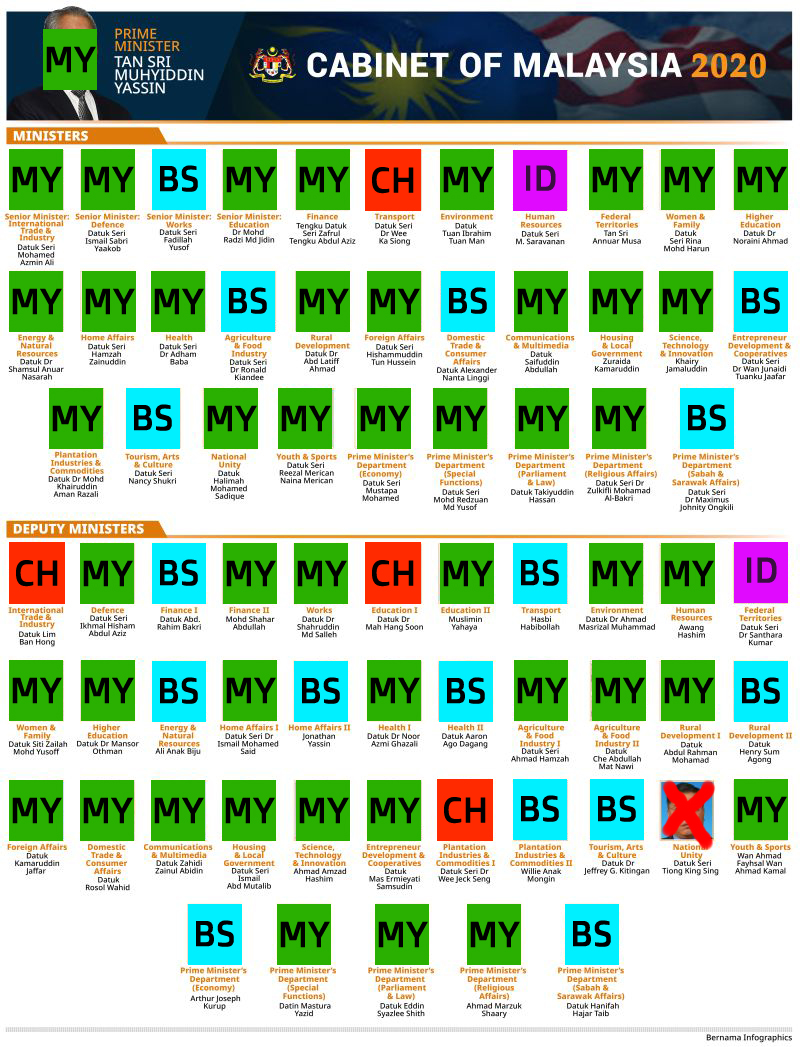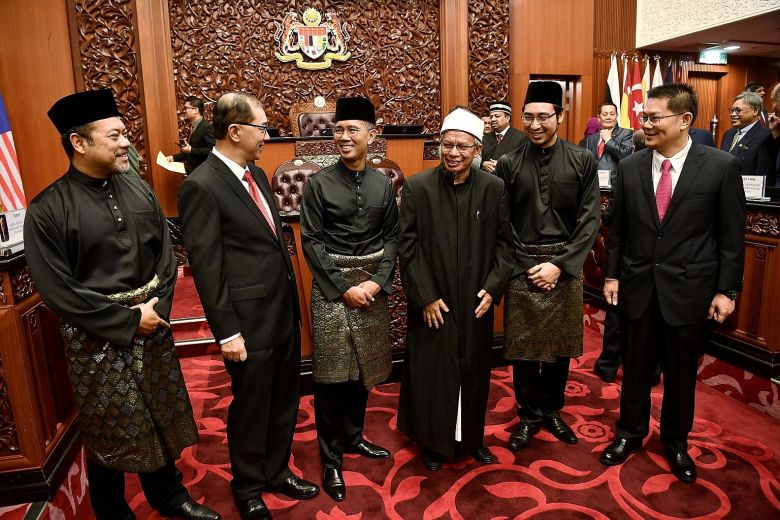Here’s why it might not be possible for Perikatan to have a ‘balanced’ cabinet

- 764Shares
- Facebook722
- Twitter9
- LinkedIn8
- Email10
- WhatsApp15
When the new Prime Minister Muhyiddin Yassin announced his new Cabinet of ministers last week, quite a few hatchiuuuus of relief were heard. Malaysia now has a government, the political crisis is over, and we can go back to worrying about the coronavirus pandemic. Hip hip hurrah!
Well, if you have been following Malaysian politics for a while already, you’d know better than to celebrate too early. It’s rare for any big political event to happen in Malaysia without some Drama™ being involved, and besides the usual complaints about the apparently questionable process behind how the Cabinet came to be…
Some people are saying that the Cabinet is imbalanced

A few days after the announcement of the minister and deputy lineup, many people have announced their issues with the lineup in terms of inclusivity and fairness. The Women’s Aid Organization (WAO) sent out a press release expressing their disappointment that women continue to be under-represented in the new Cabinet, and five groups representing the Orang Asli community had came forth and accused the government of sidelining them for not appointing an Orang Asli MP as a minister.
But other than inclusion based on race or gender, perhaps the biggest issue had been the representation of Perikatan Nasional’s component parties in the Cabinet. Besides someone asking why the sole representative of the Sarawak United People’s Party (SUPP) had not been appointed as a minister, UMNO leaders have criticised the Cabinet for not including more of them as ministers, saying that their party’s representation is not proportionate.
UMNO’s deputy president, Datuk Seri Mohamad Hasan, have also pointed out that UMNO MPs that did make it into the Cabinet were given ‘non-critical’ ministerial positions as well.
“This isn’t fair with the number of MPs contributed by Umno and the level of experience which they possess… It is not the most important thing for Umno to hold the government position in the current political climate, but it is important for Muhyiddin to take cognisant of party proportions,” – Mohamad Hasan, as reported by The Star.
Besides that, UMNO MPs from Sabah had also apparently been forgotten in the Cabinet, and according to Datuk Bung Mokhtar Radin, they’re pretty angery about it.
“…some of our members are getting angry and are complaining. They are unhappy that none of the Umno MPs from Sabah had been included in the Cabinet.” – Bung Mokhtar Radin, as reported by Malay Mail.
For the record, PAS seemed pretty chill about not having a lot of their own as ministers, so that’s nice. Regardless of that, to sum up, the concerns so far is that there’s not enough of a certain gender, race, or party in the new Cabinet. But how serious are these concerns, and could they have been prevented? To answer these questions…
We’ll be comparing the ratios in the current Cabinet to the ‘ideal’ ratio
Well, not exactly ideal in a sense that everybody will be happy with it, but ideal in the sense that it will be backed by statistics, so it will be harder to complain about without sounding greedy. It’s easier to understand in action, so let’s just get into it. For this exercise, we’ll be looking into three metrics:
- Gender
- Race
- Political parties
We’ll go through these one by one.
1. Gender
Disregarding what each minister or deputy identifies as, here is what the current Cabinet looks like, gender-wise:

The red ‘x’ there is Mr Tiong King Sing, who had turned down the post of Deputy National Unity Minister, so we won’t be including him in the calculations. Currently, we have 69 people in the Cabinet (tee hee), and of that, only 9 are women, or roughly 13% of the Cabinet. The remaining 87% are men.
So is 13% too little or too many? For this, we’ll look at two things: the national ratio, and what Perikatan Nasional has to work with. In 2019, the ratio of males to females in Malaysia is 107 to 100, which gives us roughly 52% males and 48% females. Judging by that alone, Perikatan would need to increase the number of women in its Cabinet by 35%, or replace roughly 24 men with women.

This would make the hypothetical Cabinet be made up of 36 men and 33 women. However, of all the MPs affiliated with Perikatan, only 13 out of 112 are women, so unless Perikatan appoints 20 female Senators to make the Cabinet exactly representative of the nation’s gender, the best ratio they can get is roughly 81% men and 19% women.
2. Race
For race, it’s a bit complicated, and we’ll have to make some assumptions. Since the issue brought up with the Cabinet’s racial makeup this time regards an Orang Asli MP not becoming Minister, we couldn’t just lump all the Bumiputras in one category, as is often done in Malaysia’s demographic statistics. For Peninsula politicians, we know that there’s only one Orang Asli MP, but for East Malaysia, which race politicians belong to can get a little blurry.
Taking Bung Moktar for example, he has both Malay and Sungai ancestries. While he’s undoubtedly Bumiputra, is he categorized as Malay, or Orang Asal? There’s no sure fire way to tell which race each politician identifies as in East Malaysia, so we will be categorizing them by name. This may be a bit irresponsible as even people with Chinese-sounding names might actually be categorized as Bumiputra, so feel free to correct us if you know what they identify as.
Also, we won’t be considering the smaller subdivisions of race, like Hakka Chinese or Bugis Malay or whatever, so we will only use five categories: Malay (MY), Chinese (CH), Indian (ID), Orang Asli (OA), and Bumiputra Sabah/Sarawak (BS). Anyway, here’s the makeup of the current Cabinet, in terms of race:

So currently, the Perikatan Cabinet is made of roughly 68% Malays, 6% Chinese, 3% Indians and 23% East Malaysian Bumiputras. Based on population data we derived from 2015 and 2018 and adjusting percentages after excluding non-citizens and other races, Malaysia’s population is roughly 54.3% Malays, 23.1% Chinese, 7% Indians, 14.8% Sabah/Sarawak Bumiputras, and 0.7% Orang Asli.
It might sound confusing, so we’ve plotted the percentage of these races nationally and in the new Cabinet side by side in a graph for easy comparison.

As you can see, for races where the blue bar is smaller, that means that their percentage in the population is smaller than their percentage in the Cabinet, meaning over-representation. If the red bar is smaller, they are under-represented. There is quite a disparity in the Cabinet, so to even out the difference, the Cabinet would hypothetically need to
- take out around 10 Malay and 6 East Malaysian Bumiputras, and
- add in around 12 Chinese, 3 Indians, and 1 Orang Asli.
So this new hypothetical Cabinet would have 37 Malay Cabinet members, 10 East Malaysian Bumiputras, 1 Orang Asli, 16 Chinese, and 5 Indians. However, this may not be possible because while Perikatan does have 1 Orang Asli MP, they don’t have that many Chinese and Indian MPs. Of the 3 Chinese and 2 Indian MPs they have, 4 are already in the Cabinet, and the remaining 1 turned down the position.
Moving on to parties…
3. Political parties
Now, on to perhaps the main source of contention. As you might already be aware, Perikatan Nasional is made up of 5 political parties: from BN (UMNO, MCA, MIC), PAS, and Bersatu/PPBM, as well as two coalitions from Sabah (GBS, Gabungan Bersatu Sabah) and Sarawak (GPS, Gabungan Parti Sarawak) being allied to them. MPs and Senators from these parties/coalitions as well as independent Senators make up the current Cabinet, like so:

As you can see, UMNO and Bersatu make up the majority of the Cabinet, holding 24.6% and 36.3% of the positions respectively. This is no surprise, considering that they have the most MPs in Perikatan Nasional. However, if you compare the Cabinet’s composition and Perikatan MPs…

…we can see that PPBM/Bersatu is quite overrepresented, having around 9% more representation in the Cabinet than they do in the coalition. UMNO, on the other hand, is quite under-represented, having about 10% less representation than they do in Perikatan. Other disparities aren’t quite obvious, but if Perikatan is to match their Cabinet representation with their coalition’s makeup, they need to
- take out 7 PPBM, 3 MCA, 2 Independent and 1 GBS Cabinet members, and
- add in 7 UMNO, 3 GPS, and 3 PAS Cabinet members.
This would make the new hypothetical Cabinet have 18 members from PPBM, 24 from UMNO, 11 each from PAS and GPS, 1 each from MCA and MIC, 2 from GBS, and 1 Independent member.
So these are the metrics we’ve analyzed, and by now, you might have noticed a problem…
Perikatan may not be able to come up with a ‘fair’ and ‘balanced’ Cabinet

Let’s recap what needs to be done for Perikatan to have a ‘fair’ and ‘balanced’ Cabinet so far.
- To make it representative in terms of gender, they need to replace 24 male Cabinet members with women.
- To make it representative in terms of race, they need to take out 16 Bumiputras and add in 12 Chinese, 3 Indian and one Orang Asli member.
- To make it fair in terms of party representation, they need to replace 13 PPBM, MCA, GBS and Independent members with UMNO, GPS and PAS members.
So can all these be realistically done? Probably not. The first hurdle, gender, is already explained before: Perikatan simply don’t have that much women MPs hanging around. Sure, they can appoint female Senators, but they have to think about race and political affiliations as well.
Ideally, as we’ve calculated, they need 16 Chinese and 5 Indians for a racially representative Cabinet, but based on party representation, only one of each can come from MCA and MIC. Perikatan only have 5 Chinese and Indian MPs, and since one turned down his position, Perikatan only has 4 to put into the Cabinet.
The remaining 17 needed could be from Senators, but since only one Independent slot is open in the hypothetical representative govenment, the Senators would have to come from any of the Perikatan parties except MCA and MIC.

If that sounds complicated enough already, bear in mind that there are more things we didn’t explore in this article, like regional representation (East vs West Malaysia, state vs state) and political party branches (UMNO Sabah vs UMNO Johor, for example). Due to the complexity and Perikatan not having enough of certain types of MPs, we can say that it will be neither easy nor practical for Perikatan to have this ‘fair’ and ‘representative’ Cabinet that’s beyond reproach.
Regardless of whether or not they can do it with a bit more elbow grease…
Does it matter if the Cabinet is not very representative, anyway?
Well, whether it matters or not for the new Cabinet can be up for debate, but in an ideal world, it shouldn’t matter what race, gender or political party the people in the Cabinet are, because a male minister can be aware of the issues facing women, and a Chinese minister can know about the problems facing the Malay community. As put by Dr Pamela Yong, deputy chairman of the Institute of Strategic Analysis and Policy Research,
“We should all look at the right person for the job and not look at which race he or she is… A representative should be a person who will respect the people’s mandate even over their party’s or personal interest, ” – Dr Pamela Yong, as quoted in The Star.
Sure, it can be argued that an Indian MP would know about Indian problems more intimately, but appointing an Indian minister will not guarantee that the problems will be looked at. It’s all about the right kind of people. As for whether the members of the Cabinet right now are the right kind of people… well, that’s another article for another day.
- 764Shares
- Facebook722
- Twitter9
- LinkedIn8
- Email10
- WhatsApp15

